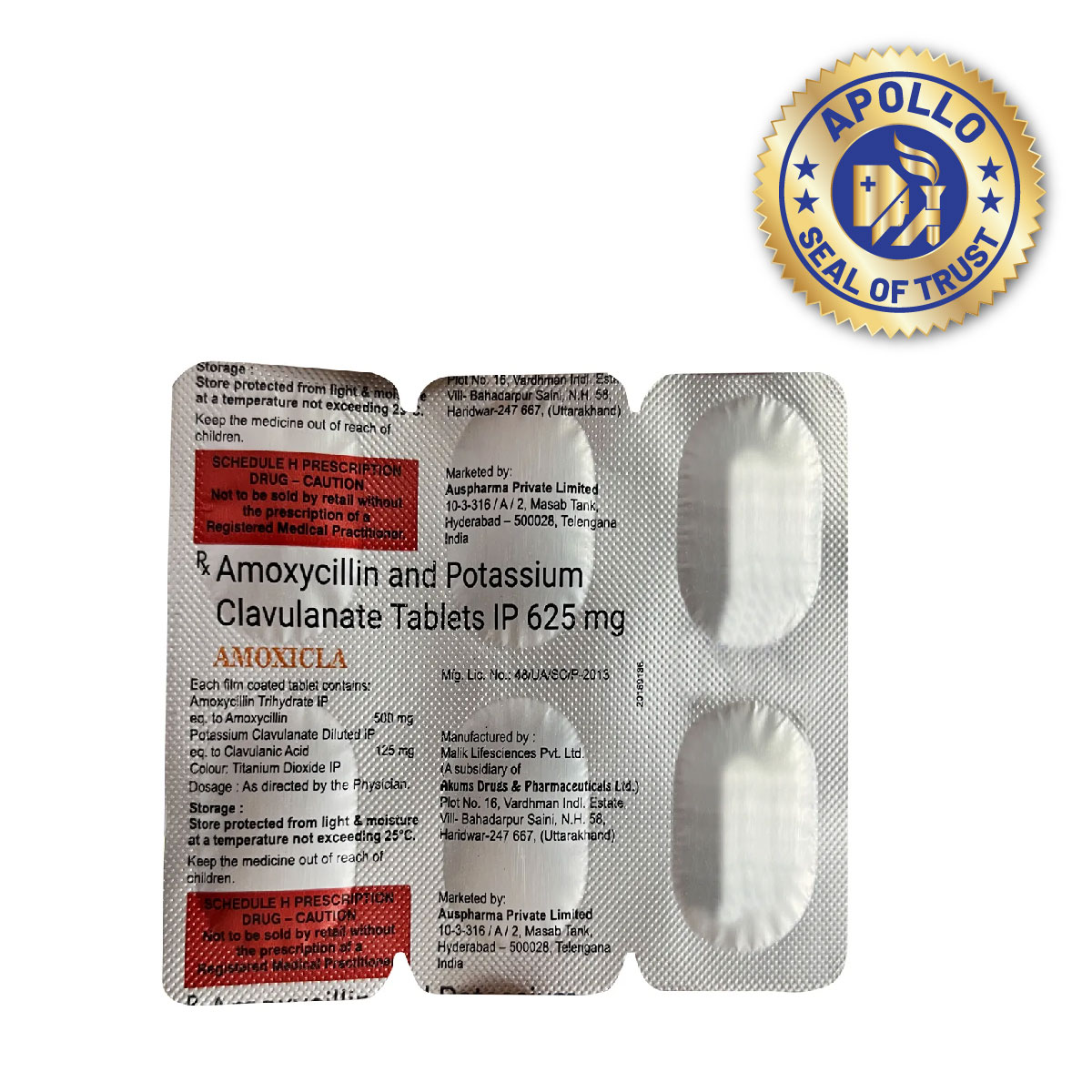Amoxicillin+clavulanic Acid
About Amoxicillin+clavulanic Acid
Amoxicillin+clavulanic Acid is used to treat bacterial infections in the body that affect the skin, soft tissues, lungs, ears, urinary tract, and nasal sinuses. It should be noted that viral infections, such as the flu and the common cold, are not treated by this medication.
Amoxicillin+clavulanic Acid consists of Amoxycillin and Clavulanic acid. This medicine works by destroying the outer protein layer, thereby killing the bacteria (bactericidal action). As a result, it helps treat infection and reduce the further spread of infection. Amoxicillin+clavulanic Acid does not work against infections caused by viruses, including the common cold and flu.
Not everyone who takes Amoxicillin+clavulanic Acid will experience these side effects. The common side effects of Amoxicillin+clavulanic Acid include vomiting, nausea, and diarrhoea. Not everyone may experience the above side effects. If you experience any discomfort, consult a doctor.
You can take Amoxicillin+clavulanic Acid with food to avoid any stomach upset. It should be swallowed as a whole with a glass of water. Do not chew, bite, crush, or break it. Your doctor will advise you on how often you should take your medicine based on your medical condition. It is always important to complete your treatment course for better results.
Before starting Amoxicillin+clavulanic Acid, please inform your doctor if you have any allergy (against any antibiotic) or any other components. Amoxicillin+clavulanic Acid is safe for children if prescribed by a doctor; the dose and duration may vary depending on the child’s weight and the severity of the infection. Inform your doctor if you are pregnant or breastfeeding before taking Amoxicillin+clavulanic Acid.
Uses of Amoxicillin+clavulanic Acid
• Bacterial Infections: Amoxicillin+clavulanic Acid is useful in treating bacterial illnesses, including pneumonia and bronchitis.
• Sinusitis: Amoxicillin+clavulanic Acid is used to treat bacterial sinus infections by lowering inflammation and cleaning them.
• Pneumonia Management: Amoxicillin+clavulanic Acid is a suitable antibiotic combination for treating community-acquired pneumonia, especially when caused by susceptible bacteria. It is often prescribed to help alleviate symptoms and promote recovery.
• Dental Infections: Amoxicillin+clavulanic Acid also treats dental infections like abscesses caused by bacteria.
• Post-Surgery Infections: Amoxicillin+clavulanic Acid can be used to prevent or treat post-surgery infections, promoting a smoother recovery.
• Urinary Tract Infections (UTIs): Amoxicillin+clavulanic Acid treats urinary tract infections caused by susceptible bacteria and provides broad-spectrum protection.
Medicinal Benefits
- Amoxicillin+clavulanic Acid belongs to the group of medicines called antibiotics.
- Amoxicillin+clavulanic Acid is used to treat bacterial infections of the ear, nose, throat, skin, bone, soft tissue, joints, urinary tract, and respiratory tract.
- Amoxicillin works by preventing the formation of the bacterial cell covering, which is necessary for the survival of the bacteria. Thus, it kills the bacteria.
- Clavulanic acid works by decreasing bacterial resistance and enhancing the activity of amoxicillin against the bacteria.
- Amoxicillin+clavulanic Acid is a broad-spectrum antibiotic that is effective against both gram-positive and gram-negative bacteria.
- Amoxicillin+clavulanic Acid helps overcome antibiotic resistance in bacteria, which is caused by the enzyme beta-lactamase.
Directions for Use
- Amoxicillin+clavulanic Acid can be taken with food to help reduce the risk of stomach upset.
- Follow your doctor's instructions on the dosage and timing of this medication.
- Swallow Amoxicillin+clavulanic Acid as a whole with a glass of water.
- Do not crush, break, or chew it.
Storage
Side Effects of Amoxicillin+clavulanic Acid
- Skin rashes
- Nausea
- Vomiting
- Bloating
- Gas
Drug Warnings
- Do not take Amoxicillin+clavulanic Acid if you have an allergy to Amoxicillin+clavulanic Acid, penicillin or cephalosporin class of antibiotics. Also, if you experience any allergic symptoms, including rash, swelling of the face/lips/throat, difficulty breathing, or chest tightness after taking Amoxicillin+clavulanic Acid, immediately contact your doctor.
- People with liver diseases or jaundice (yellowing of skin/eyes) should not take Amoxicillin+clavulanic Acid, as it can severely affect the liver.
- Inform your doctor if you have any kidney or heart disease before taking Amoxicillin+clavulanic Acid.
- The dose of Amoxicillin+clavulanic Acid can vary depending on your condition and the severity of the infection.
- Additionally, it is recommended to complete the course of medicine even if you feel better, as it is an antibiotic. Leaving it incomplete may lead to a severe infection that will, in fact, stop responding to the antibiotic as well (antibiotic resistance).
Drug Interactions
Drug-Drug Interaction: Amoxicillin+clavulanic Acid may have interaction with anti-gout (allopurinol, probenecid), anticoagulants (warfarin), anti-cancer (methotrexate), and immunosuppressant (mycophenolate mofetil).
Drug-Food Interaction: No interactions found/established.
Drug-Disease Interaction: Amoxicillin+clavulanic Acid may have interactions with colitis (inflammation in the lining of the colon), mononucleosis (viral infection with sore throat and fever), haemodialysis, and liver and kidney dysfunction.
Drug-Drug Interactions Checker List:
Safety Advice

Alcohol
cautionLimit or avoid consuming alcohol while taking Amoxicillin+clavulanic Acid to prevent unpleasant side effects.

Pregnancy
cautionDuring pregnancy, this medication should be used only when clearly needed. Discuss the risks and benefits with your doctor.

Breast Feeding
consult your doctorThis medication passes into breast milk. Consult your doctor before breast-feeding.

Driving
cautionAmoxicillin+clavulanic Acid may cause dizziness. So, drive only if you are alert and omit driving and operating machinery if you feel dizzy.

Liver
cautionAmoxicillin+clavulanic Acid to be taken with caution, especially if you have a history of liver diseases. Dose may have to be adjusted by your doctor.

Kidney
cautionAmoxicillin+clavulanic Acid to be taken with caution, especially if you have a history of kidney diseases. Dose may have to be adjusted by your doctor.

Children
cautionThe dose and duration may vary depending upon the child’s weight and the severity of the infection.
Habit Forming
Diet & Lifestyle Advise
- Antibiotics can alter the useful bacteria in the stomach, which help with indigestion. Therefore, you are advised to take foods rich in probiotics such as yoghurt/curd, kefir, sauerkraut, tempeh, kimchi, miso, kombucha, buttermilk, natto and cheese.
- Eat fibre-rich food like whole grains, beans, lentils, berries, broccoli, peas and bananas.
- Avoid foods rich in calcium, grapefruit and grapefruit juice as they might hinder the absorption of antibiotics.
- Avoid the consumption of alcohol to treat your condition effectively.
- Avoid the use of tobacco.
Special Advise
Amoxicillin+clavulanic Acid might affect blood and urine tests. Inform the person doing the tests that you are taking Amoxicillin+clavulanic Acid.
Patients Concern
Disease/Condition Glossary
Bacterial infection: A bacterial infection is a condition in which harmful bacteria enter, multiply, and infect our body. Infectious or harmful bacteria can make you sick and reproduce quickly in your body. These harmful bacteria produce chemicals known as toxins, which can damage tissue and make you sick. It can target any body part and multiply very quickly. When you get infected with bacteria, you can experience generalized symptoms, like fevers, chills, and fatigue. Bacteria are of various forms, commonly spherical, rod-shaped, and spiral-shaped. Bacterial infections vary from minor illnesses like sore throat and ear infections to severe brain infections like meningitis and encephalitis. Anyone can become infected with a bacterial infection. However, people with weak immune systems or taking immunosuppressive medicines are more prone to bacterial infection.
FAQs
Amoxicillin+clavulanic Acid is used to treat bacterial infections of the ear, nose, throat, skin, bone, soft tissue, joints, urinary tract, and respiratory tract.
Amoxicillin+clavulanic Acid contains Amoxicillin and Clavulanic acid. Amoxicillin works by preventing the formation of bacterial cell covering, which is necessary for the survival of the bacteria. Thereby, it kills the bacteria. Clavulanic acid works by decreasing bacterial resistance and enhancing the activity of amoxicillin against the bacteria. Together, Amoxicillin+clavulanic Acid helps in treating bacterial infections.
No, this is an antibiotic medication. You need to complete the full course even if you start to feel better to prevent return of infection and resistance to Amoxicillin+clavulanic Acid.
Yes, Amoxicillin+clavulanic Acid is known to cause stomach upset, indigestion, nausea and diarrhoea. To avoid these side effects please take Amoxicillin+clavulanic Acid with a meal. Also, Amoxicillin+clavulanic Acid should be taken at evenly spaced intervals to avoid any unpleasant side effects and for best results.
Generally, penicillin group of antibiotics are not advised to be taken with methotrexate which is used for conditions like psoriasis, rheumatoid arthritis etc as they may cause some unpleasant side effects when taken together. However, Amoxicillin+clavulanic Acid is relatively safer to take with methotrexate but only if prescribed of the doctor. It is best to discuss with your doctor about the use of the two medicines together who may weigh the pros and cons and decide what is best for you.
Amoxicillin+clavulanic Acid does not treat a viral infection like the flu or a common cold. It is best to consult the doctor to know if you need Amoxicillin+clavulanic Acid for your condition.
Yes, after taking Amoxicillin+clavulanic Acid, you may have diarrhoea. So, drink plenty of fluids and take probiotics to prevent excessive fluid loss from the body (dehydration). Do not take anti-diarrhoea medicine on your own, consult your doctor if the condition worsen.
Amoxicillin+clavulanic Acid may start to show its effects within a few hours after taking the medicine. However, you may begin to feel better after the first few days of treatment. If your symptoms do not improve or worsen, please contact your doctor.
Amoxicillin+clavulanic Acid should be taken for the duration prescribed by your doctor based on the severity of your infection. Usually, it is taken every 8-12 hours.
Amoxicillin+clavulanic Acid is generally safe when used as a doctor prescribes to treat bacterial infections. However, it may cause mild side effects, such as skin rashes, nausea, vomiting, bloating, and gas in some people. If you have any concerns about the safety of Amoxicillin+clavulanic Acid, please consult your doctor.
Amoxicillin+clavulanic Acid should not be taken by individuals allergic to any of its components or who have jaundice (yellowing of the skin). Inform your doctor if you have glandular fever, intestine inflammation, seizures, liver or kidney problems, or difficulty passing urine regularly.
Yes, the use of Amoxicillin+clavulanic Acid may reduce the effectiveness of hormonal contraceptives, such as birth control pills. This is because antibiotics like amoxicillin can affect the gut bacteria responsible for metabolizing contraceptive hormones, leading to lower hormone levels in the bloodstream. Please consult your doctor for alternative methods of preventing pregnancy or if you have any concerns while using this medication.
You should not exceed the recommended dose of Amoxicillin+clavulanic Acid, as doing so may increase the risk of side effects, such as stomach upset, liver damage, and allergic reactions. It may also lead to antibiotic resistance. If you feel that the current dose is ineffective or your infection worsens, please consult your doctor. Your doctor may adjust your dose or recommend an alternative treatment to prevent resistance.
Amoxicillin+clavulanic Acid should be stored at room temperature, away from direct sunlight. Keep it out of reach of children.
Amoxicillin+clavulanic Acid may cause allergic reactions in some individuals. Common symptoms of an allergic reaction include rash, itching, swelling, and difficulty breathing or swallowing. People who are allergic to penicillin (one of its ingredients) or other antibiotics in the same class are more likely to experience an allergic reaction. It is important to seek immediate medical attention if any signs of an allergic reaction occur.
Amoxicillin+clavulanic Acid does not commonly cause drowsiness as a side effect in some individuals. However, if you feel unusually tired after taking Amoxicillin+clavulanic Acid, please consult your doctor.
Amoxicillin+clavulanic Acid should be taken exactly as prescribed by your doctor. Typically, it should be swallowed as a whole with a glass of water. Do not crush, break, or chew it.
Do not take Amoxicillin+clavulanic Acid unless your doctor advises if you are pregnant or nursing. Please consult your doctor, as they will evaluate the benefits and risks and provide guidance tailored to your situation.
The common side effects of Amoxicillin+clavulanic Acid include skin rashes, nausea, vomiting, bloating, and gas. Most of these side effects do not require medical attention and will resolve gradually over time. However, you are advised to talk to your doctor if you experience these side effects persistently.
Amoxicillin+clavulanic Acid may interact with certain medications, such as anti-gout drugs (e.g., allopurinol, probenecid), anticoagulants (e.g., warfarin), anti-cancer drugs (e.g., methotrexate), and immunosuppressants (e.g., mycophenolate mofetil). To ensure safe treatment, it is essential to inform your doctor about all the medications you are currently using, including supplements and over-the-counter drugs. Your doctor can help manage potential interactions and provide personalized guidance.
If you overdose on Amoxicillin+clavulanic Acid, seek immediate medical attention or go to your nearest emergency room. Overdose symptoms of Amoxicillin+clavulanic Acid may include nausea, vomiting, skin rash, drowsiness, diarrhoea, stomach pain, and decreased urination.





